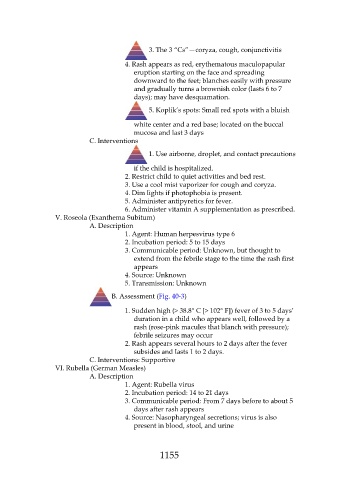Page 1155 - Saunders Comprehensive Review For NCLEX-RN
P. 1155
3. The 3 “Cs”—coryza, cough, conjunctivitis
4. Rash appears as red, erythematous maculopapular
eruption starting on the face and spreading
downward to the feet; blanches easily with pressure
and gradually turns a brownish color (lasts 6 to 7
days); may have desquamation.
5. Koplik’s spots: Small red spots with a bluish
white center and a red base; located on the buccal
mucosa and last 3 days
C. Interventions
1. Use airborne, droplet, and contact precautions
if the child is hospitalized.
2. Restrict child to quiet activities and bed rest.
3. Use a cool mist vaporizer for cough and coryza.
4. Dim lights if photophobia is present.
5. Administer antipyretics for fever.
6. Administer vitamin A supplementation as prescribed.
V. Roseola (Exanthema Subitum)
A. Description
1. Agent: Human herpesvirus type 6
2. Incubation period: 5 to 15 days
3. Communicable period: Unknown, but thought to
extend from the febrile stage to the time the rash first
appears
4. Source: Unknown
5. Transmission: Unknown
B. Assessment (Fig. 40-3)
1. Sudden high (> 38.8° C [> 102° F]) fever of 3 to 5 days’
duration in a child who appears well, followed by a
rash (rose-pink macules that blanch with pressure);
febrile seizures may occur
2. Rash appears several hours to 2 days after the fever
subsides and lasts 1 to 2 days.
C. Interventions: Supportive
VI. Rubella (German Measles)
A. Description
1. Agent: Rubella virus
2. Incubation period: 14 to 21 days
3. Communicable period: From 7 days before to about 5
days after rash appears
4. Source: Nasopharyngeal secretions; virus is also
present in blood, stool, and urine
1155

